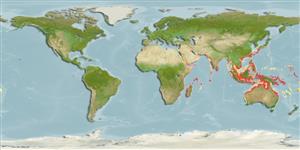Common names from other countries
>
Ovalentaria/misc (Various families in series Ovalentaria) >
Ambassidae (Asiatic glassfishes)
Etymology: Ambassis: Derived from Greek, anabasis = climbing up (Ref. 45335).
More on author: Cuvier.
Environment: milieu / climate zone / depth range / distribution range
Ecologia
marino; acqua dolce; salmastro demersale. Tropical
Indo-West Pacific from Algoa Bay in South Africa, north to the Red Sea, Seychelles, and eastward around India and Australasia to the Philippines and China (Ref. 50956).
Size / Peso / Age
Maturity: Lm ? range ? - ? cm
Max length : 10.0 cm SL maschio/sesso non determinato; (Ref. 52193)
Short description
Chiavi di identificazione | Morfologia | Morfometria
Spine dorsali (totale) : 7 - 8; Raggi dorsali molli (totale) : 8 - 10; Spine anali: 3; Raggi anali molli: 8 - 11. Diagnosis: Ambassis dussumieri has the following combination of characters: supraorbital spines 1-5, usually 3-4; rostral spine present; rear margin of preopercle smooth (at least dorsally); interopercle edge smooth; two rows of cheek scales; predorsal scales 13-16; lateral line discontunuous; lower gill rakers 22-25; pectoral-fin rays 14-16 (Ref. 50956).
Occurs in estuarian and coastal areas but also in freshwaters (Ref. 57749). Generally occurs in the seas and estuaries, but also found in rivers within tidal influence (Ref. 4833). Also Ref. 43640.
Life cycle and mating behavior
Maturities | Riproduzione | Spawnings | Egg(s) | Fecundities | Larve
Maugé, L.A., 1986. Ambassidae. p. 297-298. In J. Daget, J.-P. Gosse and D.F.E. Thys van den Audenaerde (eds.) Check-list of the freshwater fishes of Africa (CLOFFA). ISNB, Brussels; MRAC, Tervuren; and ORSTOM, Paris. Vol. 2. (Ref. 4180)
IUCN Red List Status (Ref. 130435)
CITES (Ref. 128078)
Not Evaluated
Threat to humans
Harmless
Human uses
Pesca: di nessun interesse
Strumenti
Special reports
Download XML
Fonti Internet
Estimates based on models
Preferred temperature (Ref.
115969): 24.6 - 29, mean 28 (based on 1014 cells).
Phylogenetic diversity index (Ref.
82804): PD
50 = 0.5000 [Uniqueness, from 0.5 = low to 2.0 = high].
Bayesian length-weight: a=0.01230 (0.00515 - 0.02940), b=3.01 (2.82 - 3.20), in cm Total Length, based on LWR estimates for this Genus-body shape (Ref.
93245).
Trophic level (Ref.
69278): 3.4 ±0.4 se; based on size and trophs of closest relatives
Resilienza (Ref.
120179): Alto, tempo minimo di raddoppiamento della popolazione meno di 15 mesi (Preliminary K or Fecundity.).
Fishing Vulnerability (Ref.
59153): Low vulnerability (10 of 100).
